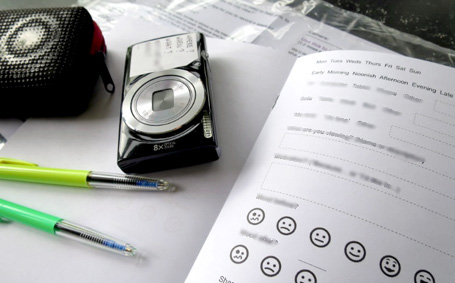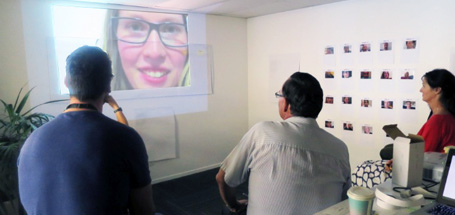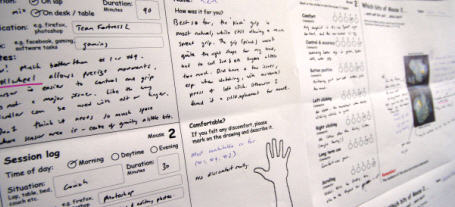Two and three at a time, 25 diary study packs arrived back by courier – this time containing not just logbook and photos but a video camera – 300+ self-recorded clips from selected moments during the previous week.
I had no idea what to expect from the video, but very quickly began to wonder why I hadn’t done this before?
Yep, after watching the first few clips I had struck ethno-gold by using video-selfies in a diary study project.
Diary studies are great for capturing interactions with a product or service which play out over time. I’ve tended towards keeping things old-school with paper based diary studies followed by exit interviews and always been pleased with the results, but after adding video to the mix, it’ll be hard to look back from here.
What resulted was a raft of in-the-moment, rich and raw footage offering an intimate, personal perspective which unfolds beautifully over time. With clips from different times of day, contexts etc. you really get a feel for the way the person’s week went and feel somehow more connected to their mindset during each interaction or moment they documented.

Self-shot video combined with stills and printed verbatims combine to provide a powerful platform for conversation.
Here’s how the project unfolded, and a few things I learned along the way:
How to capture the footage?
We looked at a few options, with our main goal being to keep things as simple as possible for the participants capturing the data, and us wrangling it later.
We considered using their own phones, setting up video blogs, and even using managed services like www.watchmethink.com, but we needed to move fast and to have control over the technology and format, so opted for buying a fleet of cameras. No guesswork!.
We went for fairly basic and compact point-and-shoot cameras with HD video and of course stills too. Looking back it’s hard to think of a cleaner, simpler way to go about it.
Setting up the diary packs:

Camera-CHECK, Charger-CHECK, Logbook-CHECK etc….
We put together 25 identical packs, containing;
- Camera with stills and video capability.
- Intro sheet – describing the objectives of the project and where the participant fits in.
- Idiot-proof instructions on how to use the camera – recording video, charging etc.
- Guidelines on some types of moments to capture with video.
- Log book and pens, with a mix of simplified multi-choice checkboxes for recording the what, where, when, and how, plus an open text field for the why?…which is what we were most interested in.
Keep it loose.
The last thing you want is a participant thinking twice whether the thing they think is important will be useful to you, so don’t be too prescriptive with your suggestions of which moments are worth capturing.
I had figured on filming a sample clip to give people an idea what I was looking for, but am glad I didn’t as our sample exercised their creative freedom to capture some surprising moments in ways and from contexts we never would have imagined.
We let our participants decide themselves which moments were important / relevant to them. This seemed a little ‘open to interpretation’ but paid off in spades as it revealed key differences between individuals – super relevant to our study.
Unboxing and setup.
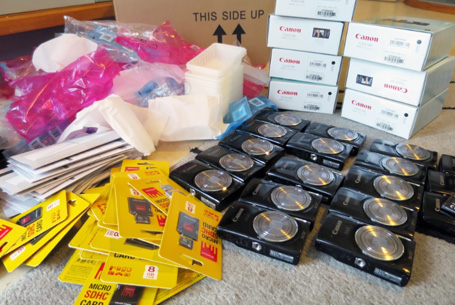
Allow several hours for getting the cameras ready. (I completely underestimated this).
Next time I’d make this a two person production line – opening boxes and packaging, charging batteries, prying SD cards from impenetrable plastic shells, printing info sheets, numbering and assembling all the kits.

Come face to face with consumer guilt as you unpack all this guff.
If you’re of the green persuasion, perhaps go plant a tree afterwards to get over the consumer guilt of dealing with all the packaging. Ok, better make that two trees actually.
Set up every camera the same, particularly the video capture resolution. This saves handling different image formats during editing.
Test pilot.
Absolutely DO Run a pilot. Ask a friend or two to follow your instruction sheet to shoot a couple of clips. You’ll quickly discover where more information, (or less) is needed in your supporting material.
Say what?
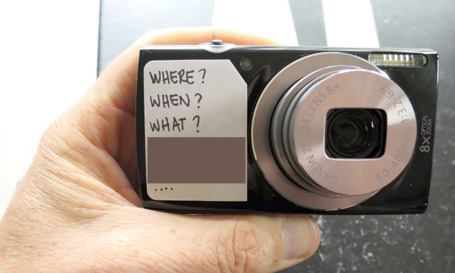
Get creative with your prompts, but let your participants do their own thing too.
We put a sticker next to the lens with some very loose prompts to help our participants get to the ‘why?’. We did this after the pilot session and it worked a treat across the sample.
Packs away!
Include your contact details in each pack, on the camera if you can, so participants can let you know if something’s up. I’ve been contacted on every diary study I’ve done.
Also, a day or so after they’ve received the pack, call the participants to make sure they are in the groove with what’s expected of them. Keep this call short, a minute or two should do the trick.
Primed to share.
I’ve found diary study data is pretty bland on it’s own and the real flavour of the individual comes through in the exit interview. Somehow the act of logging their actions raises participants awareness of their intentions and behaviours. While there may be some downside to this, I believe this ‘priming’ opens some doors in their mind, making for deeper and more valuable, access-all-areas exit interview conversations.
Say vs. do.
I like to think I’ve got a great bullshit detector, but hearing participants speak in retrospect about their behaviour during the week, and comparing that to the self footage was a good reminder that what people say they do and what they actually do can be very different. For this reason, be sure to watch some of the footage before the exit interview, and even better then watch it again without he participant. They might even surprise themselves.
Pulling it all together.
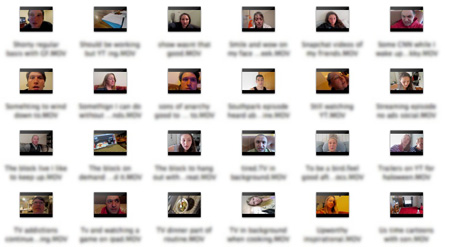
With so many clips to sort through I key-worded the file names to remind me what they contained.
How to handle and share all that footage?.
From the 300 or so short clips I weaved together a carefully edited highlight reel of a few dozen ‘moments’ from the video-selfies. When combined with snippets from the exit interviews, this offered a colourful and authentic ‘voice of the customer’ narrative as a ‘week in the life’ unfolded across many contexts.
Being there in the moment.
I’ll definitely be doing this again, but welcome any other techniques for getting into people’s lives when it’s just not possible to be there in the moment. I know there are other ways to approach this, so please hit me with your top tips in the comments below…
Or go ahead and record a selfie?
